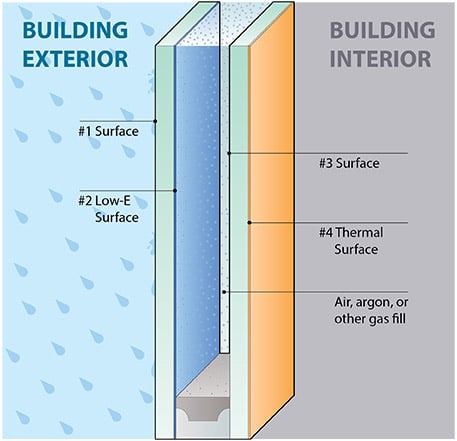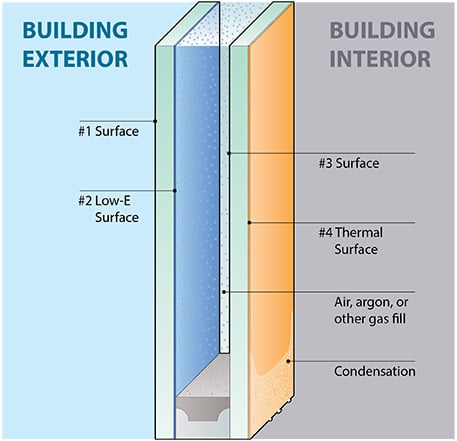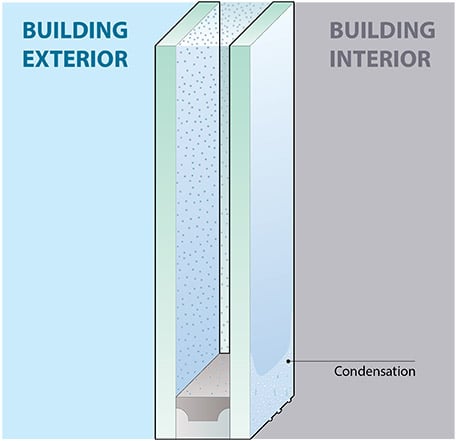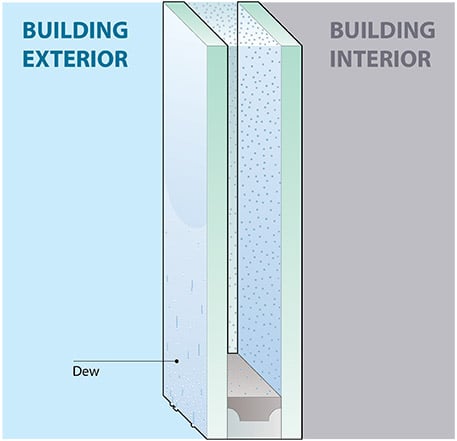What Is Condensation?
As you may have first learned in science class, condensation is a phase in Earth’s water cycle in which water vapor in the air condenses into liquid water. Condensation occurs when warm, moist air encounters a cold surface that is at or below the dew point of the air. When discussing condensation, it is also important to remember that warm air can hold much more water than cold air. When warm air cools it will create condensation or ‘dew’ on surrounding surfaces.
When it comes to window glass, condensation can occur on both on the innermost surface and the outer most surface of a properly-functioning, hermetically sealed insulating glass unit (IGU). This mostly depends on temperature and relative humidity. However, other factors such as exterior wind speed, window/door materials, curtains or window shades, forced air heaters and air exchangers have effects on condensation.

An insulating glass unit (IGU) consists of multiple layers of glass lites, coatings and either air or gas fill that can be used to create windows that are energy efficient and protect interiors from the elements.

Condensation can occur on the innermost and outermost surfaces of an IGU, largely due to factors such as air and surface temperature and humidity.
In colder months and climates, when the indoor temperatures are kept warmer to protect occupants from the cold outside, the warm moist air can condense on the cooler interior surface of the window. As a result, indoor condensation is most likely to occur in fall and winter, especially in areas with an average January temperature below freezing (32 degrees Fahrenheit). Likewise, when warm outdoor air meets a cold window, water is expelled as liquid ‘dew’ which becomes visible on glass surfaces, creating exterior condensation. This is most likely to occur during warm summer months when the interior of the building is kept cool with air-conditioning.
Condensation on window glass is often considered an unsightly annoyance, especially in buildings with many large glass surfaces. It can hinder views, drip onto interior floors and even freeze on the glass surface. However, condensation does not mean that the glass is in any way defective or inferior – it’s merely a natural phenomenon related mostly to temperature differential.
Why Does Condensation Occur?
Exterior condensation in the morning can actually be evidence that your window units are performing well, as this phenomenon occurs when the outside surface remains cool regardless of the warmth of the building’s interior. As night air cools, moisture is expelled and will collect on the cool glass surface.
With uncoated glass, or glass that is not enhanced with a low-emissivity (low-e) coating, there is less chance exterior condensation will occur. Without a low-e coating, the glass allows for greater heat transfer from the interior of a building to the exterior, so the temperature of the window is warmer, preventing condensation.
Low-e coatings help insulate the airspace between glass lites in an IGU and improve its overall thermal performance which makes the occurrence of condensation more likely. When the airspace in an IGU with low-e coatings is filled with a gas such as argon, the risk of condensation is even higher because argon is better insulating than air alone.
Indoor Condensation

When condensation occurs on the innermost surface of the IGU, it is often because of increased humidity in the building’s interior or, in some cases, drastically cooler indoor temperatures.
High interior humidity increases the occurrence of interior window condensation. Interior relative humidity is increased by moisture created by bathrooms, kitchens, plants and occupants. In fact, any activity that uses water (washing clothes and dishes, mopping the floor) and the burning of fossil fuels, especially natural gas and oil, adds moisture to the air. If the temperature of any material falls below the dew point temperature of the surrounding air, condensation from the water vapor in the surrounding atmosphere begins to form on the surface.
There are a range of performance tests and standards that glass and window manufacturers may carry out to evaluate how their glass performs against condensation, but it’s worth noting that condensation may still occur even after rigorous attention is devoted to testing or simulation to select the proper products. Some of the causes of this unexpected interior condensation include:
- Outdoor conditions that are more severe than those specified for the simulation or test.
- Air leakage through the framing system.
- Indoor environmental conditions that are different than those specified for the simulation or test. For example: If the specified indoor relative humidity was 40%, but the actual relative humidity is higher, condensation may occur.
- Changes in the interior space such as:
- Partitions, shades, obstacles, etc. that influence air movement across the glass surface.
- Plants, aquariums, etc. that increase relative humidity, though often only in the microclimate adjacent to the glass.
Outdoor Condensation

When condensation occurs on the outermost surface of the IGU, which is sometimes referred to as dew, this is largely because warm moist air has cooled in the night and moisture has condensed on the outermost surface of the IGU. This is often evidence that the IGU is performing well, as IGUs are designed to reduce the amount of heat that flows from the building’s interior to the outside during cold weather.
Insulating units that use high performance low-e glass are designed to reduce the amount of heat that flows from inside the building through the glass to the outside during cold weather. Since the insulating unit keeps more heat inside, the outside glass surface stays colder. If the outdoor surface temperature drops below the outdoor dew point temperature, condensation may form.
If the outdoor humidity is low and if wind blows against the glass, condensation usually will not appear. But on cool, clear nights, when there is no wind, and high relative humidity, condensation often forms on outdoor glass surfaces. If the condensation disappears when the sun comes up and warms the air, the insulating glass is working properly.
Non-insulated glass also can have a similar problem when a building is very air conditioned compared to the warm humid air of the summer. Insulation would prevent exterior condensation in this case.
Can I Eliminate or Reduce Condensation?
There is NO practical way to eliminate condensation entirely. To significantly reduce the risk of condensation occurring, you will have to trade off something else, such as high insulation performance. Single pane windows without a low-e coating are less likely to produce condensation when the building is being heated. Given today’s sustainability goals and green building codes, this is often not an ideal choice.
However, there are ways to reduce the temperature on the surface of the glass in a way that doesn’t significantly impact insulation performance, and these methods have been shown to help reduce condensation. One such method is applying a tint to the exterior surface of the glass. Darker glass will warm more quickly when the sun shines on it, allowing its surface temperature to warm and remove exterior condensation.
In certain cases, moving a low-e coating from surface #2 to surface #3 may help to reduce the risk of condensation. However, this will impact the solar heat gain. Regardless of where a low-e coating is placed—on #2 or #3—the winter nighttime U-value, and the associated insulation performance, will remain the same.
Updated on February 27, 2024




